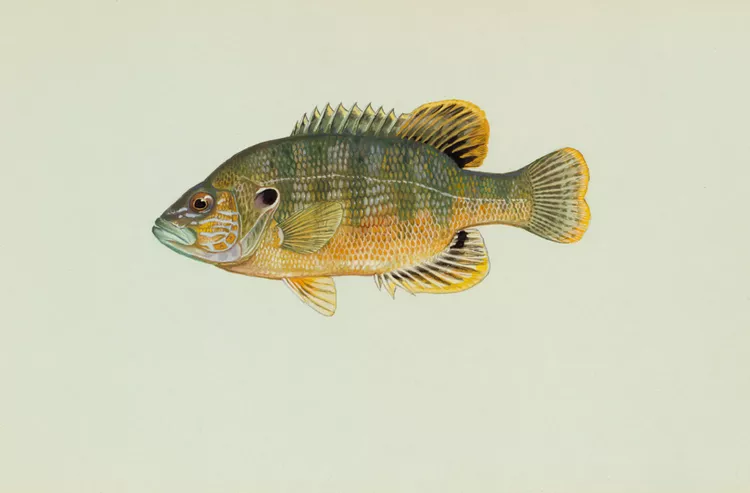Summary:
Facts About Green, Longear, Mud, Pumpkinseed, Redbreast, and Redear Sunfish.
The term “sunfish” refers to a scientifically defined group of species. This includes many popular angling targets in North America, among them largemouth bass and smallmouth bass. Of the true sunfish, bluegill are perhaps the most sought after and commonly caught in North America. Crappie are not far behind. Here are facts about the life and behavior of six other commonly found sunfish species: green sunfish, longear sunfish, mud sunfish, pumpkinseed sunfish, redbreast sunfish, and redear sunfish.
Green Sunfish
The green sunfish, Lepomis cyanellus, is a widespread and commonly caught member of the Centrarchidae family. It has white, flaky flesh like other sunfishes, making it a desirable food fish.
ID. This species has a slender, thick body, a fairly long snout, and a large mouth with the upper jaw extending beneath the pupil of the eye. Its characteristics resemble those of the warmouth and smallmouth bass. It has short, rounded pectoral fins, along with connected dorsal fins and an extended gill cover flap, or “ear lobe.” This lobe is black with a light red, pink, or yellow edge, while the body is usually brown to olive or bluish-green, exhibiting a bronze to emerald green sheen that fades to yellow-green on the lower sides and yellow or white on the belly.
Size. Average lengths are around 4 inches, typically ranging from 2 to 8 inches, with a maximum rare size of 12 inches. Most green sunfish weigh less than half a pound. The all-tackle world record is a 2-pound 2-ounce fish caught in Missouri in 1971.
Habitat. Green sunfish prefer warm, still pools and backwaters of sluggish streams, as well as ponds and small shallow lakes. They are often found near vegetation and may establish territory near the water’s edge, underbrush, rocks, or exposed roots.
Food. Their diet mainly includes dragonfly and mayfly nymphs, caddisfly larvae, midges, freshwater shrimp, and beetles, with small fish like mosquitofish occasionally consumed.
Angling Summary. Green sunfish are commonly caught using standard panfishing methods.
Longear Sunfish

Similar in size and appearance to the pumpkinseed sunfish, the longear sunfish, Lepomis megalotis, is an excellent gamefish on light tackle, although it is often considered too small to be avidly pursued. Its white, sweet flesh is notable for its taste.
ID. This stout-bodied sunfish is not as compressed as its relatives. The breeding male is particularly vibrant, showcasing dark red above and bright orange below, with a marbled and spotted blue pattern.
The longear typically features a red eye, orange to red median fins, and a blue-black pelvic fin, complemented by wavy blue lines on its cheek and opercle. The long, flexible black ear flap is edged with a light blue or orange line. The pectoral fin is short and rounded, often not reaching past the eye when bent forward, and the fish has a relatively large mouth.
Size. Longear sunfish can grow to 9½ inches long, averaging between 3 to 4 inches and a few ounces. The all-tackle world record is a 1-pound 12-ounce fish captured in New Mexico in 1985. Males typically grow faster and live longer than females.
Habitat. This species thrives in rocky and sandy pools of headwaters, creeks, as well as small to medium rivers, ponds, bays, lakes, and reservoirs. They frequent areas near vegetation and tend to be absent from lowland waters.
Food. Longear sunfish primarily consume aquatic insects but also feed on worms, crayfish, and fish eggs found on the bottom.
Angling Summary. Longear sunfish are commonly caught using standard panfishing methods, particularly on live worms and crickets.
Mud Sunfish

Though resembling the rock bass in color and shape, the mud sunfish, Acantharchus pomotis, is not actually a member of the Lepomis sunfish family.
ID. Mud sunfish have a rectangular, compressed body with a dusky reddish-brown back and pale brownish underbelly. The lateral line scales are pale with a broad dark stripe along the arch, featuring two straight dark bands below.
Habitat. Mud sunfish inhabit vegetated lakes, pools, and backwaters of creeks and small to medium rivers, often resting head down in vegetation.
Size. This sunfish reaches a maximum of 6 ½ inches; however, no world records are kept for this species.
Angling Summary. Mud sunfish are typically an incidental catch for anglers.
Pumpkinseed Sunfish

The pumpkinseed, Lepomis gibbosus, is among the most common and vividly colored sunfishes in the Centrarchidae family. Though small on average, it attracts young anglers due to its ease of catching, wide distribution, and abundance.
ID. Adult pumpkinseeds are olive green, adorned with blue and orange spots, and have gold streaks along the lower sides. They display dusky chain-like bars and red or orange spots on the back edge of the black ear flap, with dark wavy lines covering the second dorsal, caudal, and anal fins.
Size. Most pumpkinseeds measure about 4 to 6 inches, but some grow to 12 inches and may live up to 10 years. The all-tackle world record is a 1-pound 6-ounce fish captured in New York in 1985, though the IGFA does not show this in their all-tackle list.
Habitat. These sunfish thrive in quiet, vegetated waters, including lakes, ponds, and pools of streams. They prefer habitats with weed patches and structures like docks and logs.
Food. Pumpkinseed sunfish consume a variety of small organisms, including crustaceans, dragonfly nymphs, ants, small salamanders, mollusks, and fish.
Angling Summary. Commonly caught with standard panfishing techniques, pumpkinseeds’ small mouths require anglers to use small hooks and baits.
Redbreast Sunfish

The redbreast sunfish, Lepomis auritus, is the most abundant sunfish in Atlantic Coastal Plain streams. It is a strong fighter for its size and provides great culinary value.
ID. The body is deep and compressed, often exhibiting an olive hue that transitions to bluish bronze below. During the spawning season, males display bright orange-red bellies, whereas females have pale orange undersides. Light blue streaks emerge near the mouth, with short and stiff gill rakers.
The lobe on the gill cover is long and narrow in adult males, distinguishing them from longear sunfish. The lobe of the redbreast is blue-black and narrower than the eyes, while the longear’s is wider with a pale margin. The pectoral fins of redbreast sunfish are shorter and rounder compared to the pointed pectoral fins of redear sunfish.
Size. Growing slowly, redbreast sunfish may reach lengths of 6 to 8 inches, with some attaining 11 to 12 inches and weighing about a pound. The all-tackle world record is a 1-pound 12-ounce fish caught in Florida in 1984.
Habitat. They inhabit rocky and sandy pools of streams and small to medium rivers, generally preferring deeper stream sections and vegetated lake margins.
Food. The primary diet consists of aquatic insects, along with snails, crayfish, small fish, and sometimes organic bottom matter.
Angling Summary. Redbreast sunfish are easily caught using standard panfishing techniques.
Redear Sunfish

Known as shellcracker, the redear sunfish, Lepomis microlophus, is a popular sportfish due to its vigorous fight on light tackle and its relatively large size among sunfish. This species is excellent for eating, featuring flaky white meat.
ID. Light golden-green above, the redear sunfish has a round, laterally compressed body. Adults have dusky gray spots, while juveniles exhibit bars. Its belly ranges from white to yellow, with primarily clear fins; breeding males showcase a brassy gold coloration.
Redear sunfish have pointed snouts and small mouths, equipped with blunted molaform teeth that facilitate shell cracking. Their dorsal fins are connected, and the long, pointed pectoral fins extend well beyond the eye when bent forward, aiding in their identification against longear and redbreast sunfish.
Size. This species can reach sizes over 4½ pounds, typically averaging under half a pound and around 9 inches in length. The all-tackle world record is a 5-pound 12-ounce fish from Arizona, recorded in 2014. They can live up to eight years.
Habitat. Redear sunfish are found in ponds, swamps, lakes, and vegetated pools of rivers, favoring warm, clear, and quiet waters.
Food. As opportunistic bottom feeders, redear sunfish primarily forage during the day on aquatic snails, which contributes to their common name, “shellcracker.” Their diet further includes midge larvae, amphipods, mayfly and dragonfly nymphs, clams, fish eggs, and crayfish.
Angling Summary. Shellcrackers are typically caught with standard panfishing techniques.





